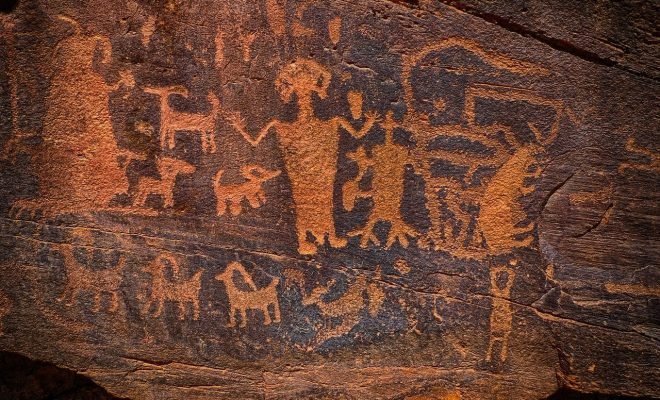Two weeks ago, I wrote an article about the Illinois Wolfman, skipping Idaho. I went back and researched Idaho for this week and found a great story. Early November, I had written an article titled Hawaii’s Little People.
The article was on Hawaii’s Menehune, which is a civilization of pygmies. The story was when the first Polynesian settlers arrived in Hawaii; they discovered structures. There were ancient buildings, dams, and parks still standing when they arrived. They attributed it to the Menehune, a race of pygmies thought to occupy Hawaii first.
It was surprising to learn that a race of little people lives in the Rocky Mountains too.
Shoshone folk tales tell of a legendary race of little people called the Nimerigar. According to the Shoshone, the Nimerigar are aggressive people that shoot poisoned arrows. Folklore says they live in the Wind River and Pedro ranges of Wyoming. Stories of the Nimerigar traveled up and down the Rocky Mountains. This range begins in the Canadian provinces of British Columbia and Alberta, then travels southward into the United States from Idaho and Montana through Northern New Mexico.
The name Nimerigar is derived from Shoshone and Paiute Native languages meaning cannibals. Native American stories of the Nimerigar’s gruesome antics abound in their tales. The Shoshone say the Nimerigar live in the Owyhee Mountains of Idaho. Shoshone folk tales say that cannibalism is how the Nimerigar feed their people. They take massive rocks and bash tribal members in the head. Only those members that can’t or won’t support their families.
The Nimerigar adults range between two and three feet tall with a row of sharp canine teeth. They kill their enemies with poisoned arrows. The Nimerigar waged war and raided the Shoshone and Paiute tribes. These little people were not nice or friendly. Parents were afraid the Nimerigar would come and kidnap their children. The tribal elders were worried the Nimerigar would cause the tribe to self-destruct.
It seems these little people liked playing pranks and tricks. The Nimerigar set innocent people up with no so-innocent antics. The Rocky Mountain tribes joined forces and defeated the Nimerigar. That is what the legends say.
Every Native American tribe has a story about “little people.” The Comanche calls them Nunnupis. The Cherokee refers to them as the Yumwi, and the Hawaiians call them the Menehune. It’s difficult not to believe that there is some truth to the race of little people. It is a widespread legend, and all tales contain elements of truth.
In 1932, two men digging for gold discovered a 14-inch-tall mummy. It wasn’t the treasure they were looking for, but it was a fascinating find. It was called the San Pedro Mountain mummy, and it raised questions. X-rays show that the mummy is an adult. Skeptical that the mummy was a hoax, the University of Wyoming ran extensive tests.
The results surprised everyone.
Carbon dating revealed that the mummy was not only an adult. He was also 65-years-old when he died with pointed teeth and a full set of canines.
Sound familiar?
The two miners discovered the adult male mummy; later examinations revealed it was an anencephalic infant. In the 1990s, anthropologist George Gill examined another mummy that was an anencephalic infant. DNA testing showed it to be Native American and radiocarbon dating dated it to about 1700.
The San Pedro Mountain mummy disappeared. It was on display for a while and then lost in the annals of history.
Whichever report you believe, the mummy is a 65-year-old man. The mummy is an anencephalic infant; rumors say the mummy brought bad luck to anyone who owned it. The Native Americans continue to warn people to be wary of the “tiny people eaters.” They still believe that the Nimerigar lives in the Rocky Mountains.
The mummy matches the description of the Nimerigar. In the 1800s, stories appear in Nashville and Middle Tennessee newspapers. Stories about a massive cemetery discovered in Coffee County, Tennessee, contained 75,000-100,00 pygmies. The dead bodies were either sitting or standing when uncovered. Coffee County farmers found the grave by plowing the field, uncovering a series of smaller graves.
The size of the remains had people thinking it was a graveyard filled with children. Upon further investigation, their skulls had wisdom teeth. Usually, wisdom teeth appear between the ages of 17 and 25 years-old. The bodies were adults and not children. The bodes belonged to a tribe of dwarf people, no bigger than 3-feet-tall. Forty years earlier, near Cochocton, Ohio, Investigators discovered another mass grave. The conjecture is that the pygmy tribe could be related to the mound builders.
The discoveries raise questions about whether the Shoshone legends contain elements of truth.
You have two burial grounds discovered with thousands of small bodies—Native American legends about a race of little people that weren’t friendly. Stories of clashes and wars with these little people passed down generations.
It is hard not to believe in the Nimerigar with so many stories, and with the discoveries of the mass grave sites and the mummy.
If you are ever hiking or driving through the remote Owyhee Mountains of Idaho? You might be lucky enough to answer the question. Is the Nimerigar real?

